What are
Restriction Enzymes?
Restriction enzymes are enzymes that cuts
double stranded DNA at unique sequence called recognition sequence or
restriction site
- Also called as molecular scissors, molecular
knives or molecular scalpels - Hind II is the first restriction nuclease
isolated from Haemophilus influenzae bacteria
Restriction Enzymes belongs to the class nucleases or nucleic acid
degrading enzymes
two types: 1. Restriction endonuclease: makes
cuts within the DNA molecule
2. Restriction exonuclease:
remove nucleotides from the ends
3 types of Restriction endonucleases:
- Type I, II and III
- Type II is used in rDNA technology as its makes cuts
within recognition site - Eg: Eco R1, Hind III
- Mg2+ is required for cleavage
- Type I and Type III makes random cuts; therefore,
rarely used in rDNA technology
How Restriction Enzymes cut DNA molecule?
Example is
Eco R1: EcoR1 Restriction site :
5`—GAATTC—3`
3`—CTTAAG—5`
Watch this video for better understanding
Characteristics of restriction sites
- Recognition sites are often 4-8 base pairs
- They are Palindromic sequences. Palindromic sequence
is a DNA sequence of base pairs that reads the same on two strands in 5`-3`
& 3`-5`direction.
Cut patterns
1.Staggered cuts or cohesive or sticky ends
- cuts that generate protruding
single stranded ends eg: Eco R1 - More preferred in rDNA
technology
![]() 5`—GAATTC—3` 5`—G AATTC—3`
5`—GAATTC—3` 5`—G AATTC—3`
3`—CTTAAG—5` ——> 3`—CTTAA G—5`
2.Blunt ends or even cuts
- cuts both strands at the same
site, generating blunt or flush ends eg: AluI
![]() 5`—AGCT—3` 5’—AG CT—3’
5`—AGCT—3` 5’—AG CT—3’
3’—TCGA—5’ ——–> 3’—TC GA—5’
DNA ligase
Ligases are Joining enzyme that
joins DNA fragments by forming phosphodiester bond. The process is called
ligation.
How DNA ligase joins DNA
molecule?
- Phosphodiester
bond is between the 5’P of a nucleotide of one DNA fragment and the 3’ OH end
of the other - Requires ATP
or NAD+ for its activity - Eg: T4 ligase





